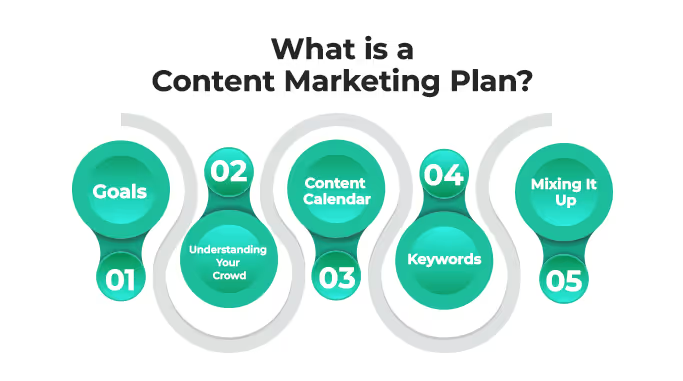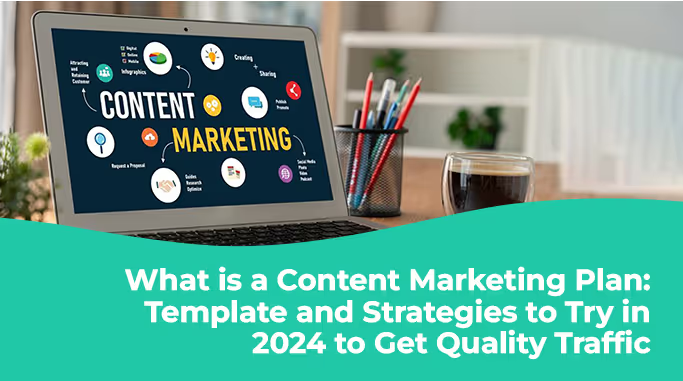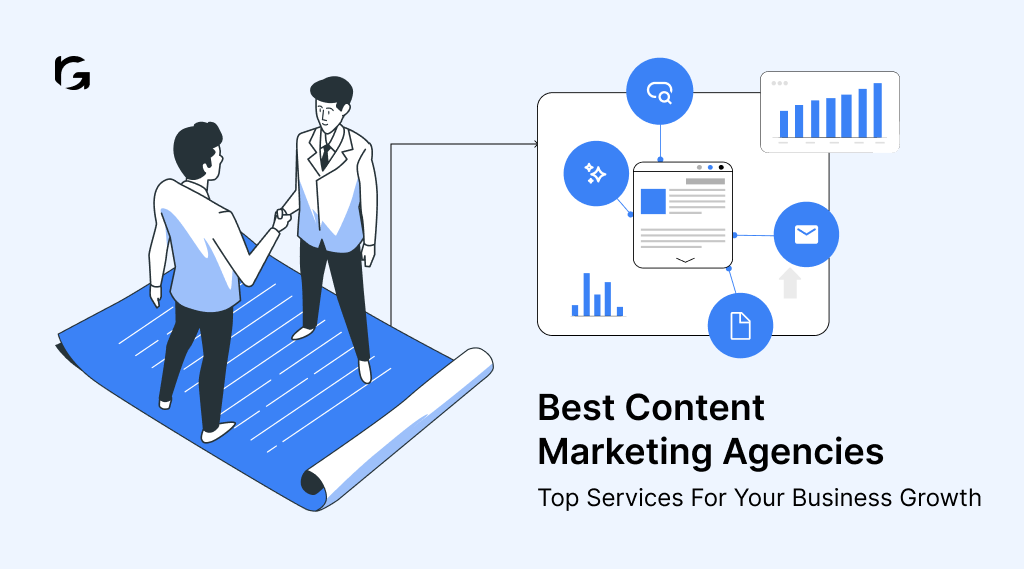Introduction
Navigating the ever-evolving landscape of digital marketing requires more than just a compass—it demands a meticulously crafted content marketing plan. As we stand on the brink of 2024, the battlefield for online visibility is fiercer than ever, making strategic prowess a non-negotiable asset. This guide is your gateway to mastering the art of content marketing, offering not just insights but a tangible template and a repertoire of cutting-edge strategies. Join me as we unravel the intricacies of crafting a content marketing plan that not only captivates your audience but propels your brand to the coveted zenith of Google rankings. Get ready to transform your content game and beckon quality traffic with the precision of a seasoned strategist.
What is A Content Marketing Plan?

A content marketing plan is like the master strategy for your brand's online presence. It's the roadmap that guides you through the digital wilderness, helping you stand out in a crowd. Here's the breakdown:1. Goals:Figure out what you want. More clicks? Higher engagement? Sales? Your goals are the North Star of your plan.2. Understanding Your Crowd:It's like being the DJ at a party—you need to know what your audience likes. Understanding their problems, interests, and habits helps tailor your content to hit the right notes.3. Content Calendar:Timing is key. A content calendar keeps you on track, making sure you're regularly putting out content that keeps your audience hooked.4. Keywords:Ever played hide and seek? Your content is hiding, and keywords are the seekers. Identify what your audience is searching for, strategically sprinkle those words, and voila—your content pops up.5. Mixing It Up:Variety is the spice of life. Don't just stick to articles—throw in videos, infographics, and interactive stuff. Different strokes for different folks, right?In a nutshell, a content marketing plan is your digital GPS, guiding you through the twists and turns of the online world.
What is included in a content marketing plan?
A content marketing plan is like a recipe for success in the digital realm. Here's what's on the menu:1. Metrics and Analytics:Numbers are your compass in the digital world. Define specific key performance indicators (KPIs) aligned with your goals—whether it's click-through rates, conversion rates, or social shares. Regularly analyze these metrics to gauge the effectiveness of your content and make data-driven decisions.2. Budget and Resources Allocation:Every masterpiece requires resources. Outline your budget considering content creation, promotion, and any necessary tools or technologies. Allocating resources strategically ensures you have the ingredients needed for a successful content strategy.3. Team Roles and Responsibilities:It takes a coordinated effort to create a symphony. Clearly define roles and responsibilities within your team, ensuring everyone understands their part in the content creation and distribution process. A well-organized team contributes to the seamless execution of your content marketing plan.4. Adaptation and Optimization Strategies:Flexibility is your secret weapon. The digital landscape is dynamic, trends evolve, and algorithms change. Build adaptation and optimization strategies into your plan. Regularly assess the performance of your content, stay updated on industry trends, and be ready to tweak your approach for ongoing success.By delving into these additional facets, your content marketing plan becomes a comprehensive guide, not just for creating content, but for navigating the complexities of the ever-changing digital landscape with precision and agility.
How do you create a content marketing plan?
Structuring a content marketing plan is like building a sturdy foundation for a skyscraper. Here's the blueprint:1. Executive Summary:Think of this as your plan's elevator pitch. Summarize your goals, target audience, and key strategies. It's a quick overview that sets the stage for what follows.2. Business Goals and Objectives:Align your content goals with the broader business objectives. Whether it's increasing brand awareness, driving sales, or boosting customer engagement, make sure your content serves a purpose.3. Target Audience Persona:Paint a vivid picture of your ideal audience. Define demographics, interests, challenges, and behaviors. This persona becomes your guiding star in crafting content that resonates.4. Content Calendar:Time to get organized. Outline a content calendar specifying what content will be created, when it will be published, and where it will be shared. This ensures a consistent flow that keeps your audience engaged.5. Keyword Strategy:Become a wordsmith. Conduct thorough keyword research and outline a strategy for integrating these keywords naturally into your content. This boosts your chances of ranking higher on search engines.6. Content Types and Formats:Variety is the spice of content. Specify the types of content you'll create—blog posts, videos, infographics, etc. Each format caters to different preferences, keeping your audience captivated.7. Distribution Channels:Your content needs wings. Identify the platforms where your audience hangs out—social media, email, or other channels. Tailor your distribution strategy to reach them effectively.8. Metrics and KPIs:Define the success metrics. Whether it's website traffic, engagement rates, or conversion numbers, establish KPIs that align with your goals. Regularly measure and analyze these metrics to track progress.9. Budget Allocation:Money talks. Outline your budget, specifying how much will be allocated to content creation, promotion, and any tools or resources needed. This ensures you have the financial muscle to execute your plan effectively.10. Team Roles and Responsibilities:Who's doing what? Clearly define the roles and responsibilities within your team. This ensures everyone knows their part in bringing the content strategy to life.11. Adaptation and Optimization Plan:Flexibility is key. Develop a plan for adapting to changing trends and optimizing your strategy based on performance data. This ensures your content marketing plan remains effective in the ever-evolving digital landscape.
5 Content marketing plan examples you should know
Let's explore five intriguing content marketing plan examples:1.Red Bull's Content Ecosystem:Red Bull doesn't just sell energy drinks; they sell a lifestyle. Their content marketing plan is an ecosystem that includes extreme sports events, documentaries, and high-energy videos. By aligning their content with their brand image, Red Bull engages its audience in a way that goes beyond traditional advertising.2.HubSpot's Inbound Marketing Strategy:HubSpot is a maestro when it comes to inbound marketing. Their content marketing plan focuses on creating valuable, educational content that attracts potential customers. From blog posts and ebooks to webinars, HubSpot's strategy revolves around providing solutions to their audience's problems, building trust, and naturally guiding them toward their products.3. GoPro's User-Generated Content Approach:GoPro's content marketing plan leverages the power of user-generated content. They encourage their customers to share their adventures captured with GoPro cameras. This not only creates a strong community but also serves as authentic, compelling content that showcases the product in action.4. Dollar Shave Club's Humorous Content:Dollar Shave Club disrupted the razor industry not just with their products but with their content. Their content marketing plan is laced with humor, resonating with their target audience. From quirky commercials to witty blog posts, Dollar Shave Club's content is a testament to the impact of injecting personality into your brand.5.Airbnb's Neighborhood Guides:Airbnb goes beyond just providing a platform for booking accommodations. Their content marketing plan includes neighborhood guides that offer travelers insights into local culture, attractions, and hidden gems. By providing valuable information, Airbnb enhances the overall travel experience for its users, establishing itself as a trusted travel companion.
Conclusion
In the dynamic landscape of content marketing, weaving a tapestry that seamlessly integrates diverse strategies is key to not only boosting lead flow but also driving a continuous surge in traffic. From crafting compelling lead magnets to embracing interactive content and strategically leveraging social proof, each strategy contributes a unique thread to this narrative of success.As we conclude, remember that the journey doesn't end with implementation—it's an ongoing evolution. Regularly analyze metrics, adapt to changing trends, and optimize your approach based on performance data. Your content marketing plan is not a static document; it's a living, breathing guide that navigates the digital realm.By embracing a holistic content marketing approach—where every piece of content serves a purpose aligned with business goals, engages the audience authentically, and adapts to the ever-evolving landscape—you're not just attracting leads and traffic. You're crafting a story of sustained growth, leaving an indelible mark in the hearts and minds of your audience. So, gear up, stay agile, and let your content journey unfold into a saga of success.Ready to dominate in 2024? Dive into our content marketing plan guide now and transform your online presence. Click here to access the ultimate strategies for quality traffic and success!



.svg)


.webp)